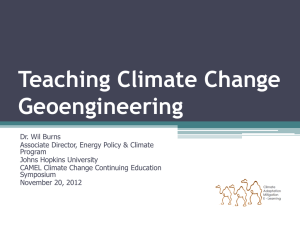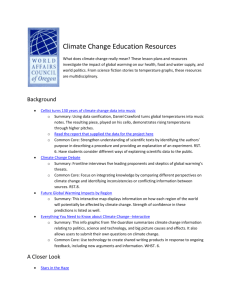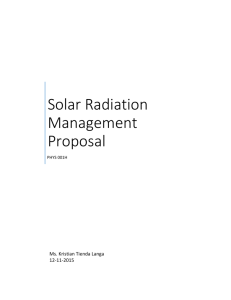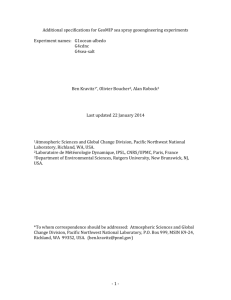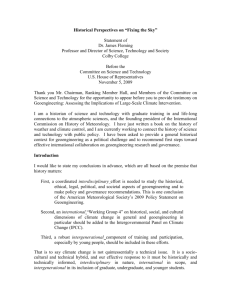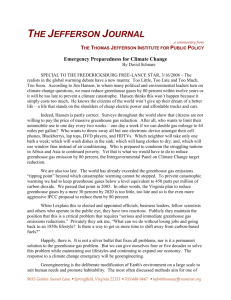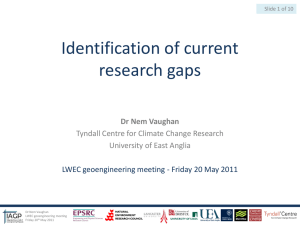20 Reasons Why Geoengineering May Be a Bad Idea
advertisement
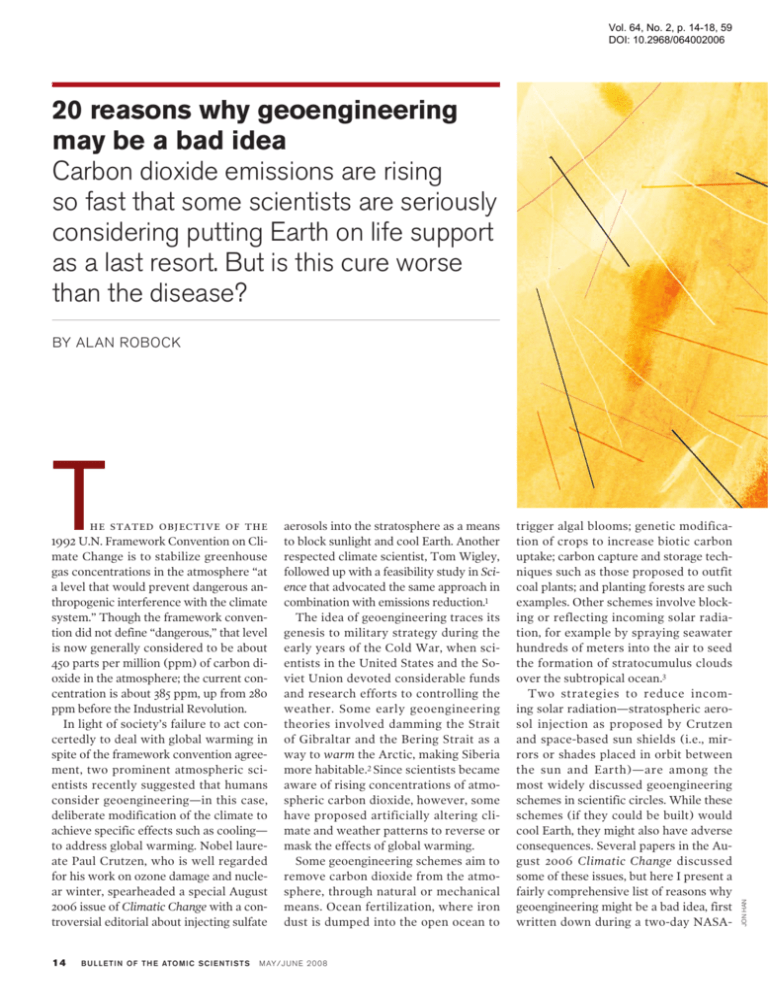
Vol. 64, No. 2, p. 14-18, 59 DOI: 10.2968/064002006 20 reasons why geoengineering may be a bad idea Carbon dioxide emissions are rising so fast that some scientists are seriously ­considering putting Earth on life support as a last resort. But is this cure worse than the disease? T he stated objective of the 1992 U.N. Framework Convention on Climate Change is to stabilize greenhouse gas concentrations in the atmosphere “at a level that would prevent dangerous anthropogenic interference with the climate system.” Though the framework convention did not define “dangerous,” that level is now ­generally considered to be about 450 parts per million (ppm) of carbon dioxide in the atmosphere; the current concentration is about 385 ppm, up from 280 ppm before the Industrial Revolution. In light of society’s failure to act concertedly to deal with global warming in spite of the framework convention agreement, two prominent atmospheric scientists recently suggested that humans consider geoengineering—in this case, deliberate modification of the climate to achieve specific effects such as cooling— to address global warming. Nobel laureate Paul Crutzen, who is well regarded for his work on ozone damage and nuclear winter, spearheaded a special August 2006 issue of ­Climatic Change with a controversial editorial about injecting sulfate 14 Bu lleti n of th e Atom ic Sc ien tists aerosols into the stratosphere as a means to block sunlight and cool Earth. Another respected climate scientist, Tom Wigley, followed up with a feasibility study in Science that advocated the same approach in combination with emissions reduction.1 The idea of geoengineering traces its genesis to military strategy during the early years of the Cold War, when scientists in the United States and the Soviet Union devoted considerable funds and research efforts to controlling the weather. Some early geoengineering theories involved damming the Strait of Gibraltar and the Bering Strait as a way to warm the Arctic, making Siberia more habitable.2 Since scientists became aware of rising concentrations of atmospheric carbon dioxide, however, some have proposed artificially altering climate and weather patterns to reverse or mask the effects of global warming. Some geoengineering schemes aim to remove carbon dioxide from the atmosphere, through natural or mechanical means. Ocean fertilization, where iron dust is dumped into the open ocean to MAY/JU N E 2 0 0 8 trigger algal blooms; genetic modification of crops to increase biotic carbon uptake; carbon capture and storage techniques such as those proposed to outfit coal plants; and planting forests are such examples. Other schemes involve blocking or reflecting incoming solar radiation, for example by spraying seawater hundreds of meters into the air to seed the formation of stratocumulus clouds over the subtropical ocean.3 Two strategies to reduce incoming solar radiation—stratospheric aerosol injection as proposed by Crutzen and space-based sun shields (i.e., mirrors or shades placed in orbit between the sun and Earth)—are among the most ­widely discussed geoengineering schemes in scientific circles. While these schemes (if they could be built) would cool Earth, they might also have adverse ­consequences. Several papers in the August 2006 ­Climatic Change discussed some of these issues, but here I present a ­fairly comprehensive list of reasons why geoengineering might be a bad idea, first written down during a two-day NASA- JON HAN By Alan robock sponsored conference on Managing Solar Radiation (a rather audacious title) in November 2006.4 These concerns address unknowns in climate system response; effects on human quality of life; and the political, ethical, and moral issues raised. 1. Effects on regional climate. Geoengineering proponents often suggest that volcanic eruptions are an innocuous natural analog for stratospheric injection of sulfate aerosols. The 1991 eruption of Mount Pinatubo on the Philippine island of Luzon, which injected 20 megatons of sulfur dioxide gas into the stratosphere, produced a sulfate aerosol cloud that is said to have caused global cooling for a couple of years without adverse effects. However, researchers at the National Center for Atmospheric Research showed in 2007 that the Pinatubo eruption caused large hydrological responses, including reduced precipitation, soil moisture, and river flow in many regions. 5 Simulations of the climate response to volcanic eruptions have also shown large impacts on regional climate, but whether these are good analogs for the geoengineering response requires further investigation. Scientists have also seen volcanic eruptions in the tropics produce ­changes in atmospheric circulation, causing winter warming over continents in the Northern Hemisphere, as well as eruptions at high latitudes weaken the Asian and African monsoons, causing reduced precipitation.6 In fact, the eight-monthlong eruption of the Laki fissure in Iceland in 1783–1784 contributed to famine in Africa, India, and Japan. If scientists and engineers were able to inject smaller amounts of stratospheric aerosols than result from volcanic eruptions, how would they affect summer wind and precipitation patterns? Could attempts to geoengineer isolated regions (say, the Arctic) be confined there? Scientists need to investigate these scenarios. At the fall 2007 American ­Geophysical Union meeting, researchers presented preliminary findings from several different climate models that ­s imulated geoengineering schemes and found that they reduced precipitation over wide regions, condemning hundreds of millions of people to drought. 2. Continued ocean acidification. If humans adopted geoengineering as a solution to global warming, with no restriction on continued carbon emissions, the ocean would continue to become more acidic, because about half of all excess carbon dioxide in the atmosphere is removed by ocean uptake. The ocean is already 30 percent more acidic than it was before the Industrial Revolution, and continued acidification threatens the entire oceanic biological chain, from coral reefs right up to humans.7 3. Ozone depletion. Aerosol particles in the stratosphere serve as surfaces for chemical reactions that destroy ozone in the same way that water and nitric acid aerosols in polar ­stratospheric clouds produce the seasonal Antarctic ozone hole.8 For the next four decades or so, when the concentration of anthropogenic ozone-depleting substances will still be large enough in the stratosphere MAY /J U N E 2 0 0 8 B ul l e tin o f the Ato mic Sc ie nt i s t s 15 capitalizing on carbon W ithout market incentives, geoengineering schemes to reflect solar heat are still largely confined to creative thought and artists’ renderings. But a few ambitious entrepreneurs have begun to experiment with privatizing climate mitigation through carbon sequestration. Here are a few companies in the market to offset your carbon footprint: California-based technology startups Planktos and Climos are perhaps the most prominent groups offering to sell carbon offsets in exchange for performing ocean iron fertilization, which induces blooms of carbon-eating phytoplankton. Funding for Planktos dried up in early 2008 as scientists grew increasingly skeptical about the technique, but Climos has managed to press on, securing $3.5 million in funding from Braemar Energy Ventures as of February. Also in the research and development phase is Sydney, Australia–based Ocean Nourishment Corporation, which similarly aims to induce oceanic photosynthesis, only it fertilizes with nitrogen-rich urea instead of iron. Atmocean, based in Santa Fe, New Mexico, takes a slightly different tack: It’s developed a 200-meter deep, wave-powered pump that brings colder, more biota-rich water up to the surface where lifeforms such as tiny, tube-like salps sequester carbon as they feed on algae. Related in mission if not in name, stationary carbon-capture technologies, which generally aren’t considered geoengineering, are nonetheless equally inventive: ­Skyonic, a ­Texas-based startup, captures carbon dioxide at power plants (a relatively well­proven technology) and mixes it with sodium hydroxide to render high-grade baking soda. A pilot version of the system is operating at the Brown Stream Electric Station in Fairfield, Texas. To the west in Tucson, Arizona, Global Research Technologies, the only company in the world dedicated to carbon capture from ambient air, recently demonstrated a working “air extraction” prototype—a kind of carbon dioxide vacuum that stands upright and is about the size of a phone booth. Meanwhile, GreenFuel Technologies Corporation, in collaboration with Arizona Public Service Company, is recycling carbon dioxide emissions from power plants by using it to grow biofuel stock in the form of—what else?—algae. KIRSTEN JERCH to produce this effect, additional aerosols from geoengineering would destroy even more ozone and increase damaging ultraviolet flux to Earth’s surface. 4. Effects on plants. Sunlight scatters as it passes through ­stratospheric aerosols, reducing direct solar radiation and increasing diffuse radiation, with important biological ­consequences. Some studies, including one that measured this effect in trees following the Mount Pinatubo eruption, suggest that diffuse radiation allows plant canopies to photosynthesize more efficiently, thus increasing their capacity as a carbon sink.9 At the same time, inserting aerosols or reflective disks into the atmosphere would reduce the total sunlight to reach Earth’s surface. Scientists need to assess the impacts on crops and natural vegetation of reductions in total, diffuse, and direct solar radiation. 16 Bu lleti n of th e Atom ic Sc ien tists 5. More acid deposition. If sulfate is injected regularly into the stratosphere, no matter where on Earth, acid deposition will increase as the material passes through the troposphere—the atmospheric layer closest to Earth’s surface. In 1977, Russian climatologist Mikhail Budyko calculated that the additional acidity caused by sulfate injections would be negligibly greater than levels that resulted from air pollution.10 But the relevant quantity is the total amount of acid that reaches the ground, including both wet (acid rain, snow, and fog) and dry deposition (acidic gases and particles). Any additional acid deposition would harm the ecosystem, and it will be important to understand the consequences of exceeding ­different ­biological thresholds. Furthermore, more acidic particles in the troposphere would affect public health. The effect may not be large compared to the MAY/JU N E 2 0 0 8 impact of pollution in urban areas, but in pristine areas it could be significant. 6. Effects of cirrus clouds. As aerosol particles injected into the stratosphere fall to Earth, they may seed cirrus cloud formations in the troposphere.11 Cirrus clouds affect Earth’s radiative balance of incoming and outgoing heat, although the amplitude and even direction of the effects are not well understood. While evidence exists that some volcanic aerosols form cirrus clouds, the global effect has not been quantified.12 7. Whitening of the sky (but nice sunsets). Atmospheric aerosols close to the size of the wavelength of light produce a white, cloudy appearance to the sky. They also contribute to colorful sunsets, similar to those that occur after volcanic eruptions. The red and yellow sky in The Scream by Edvard Munch was inspired by the brilliant sunsets he witnessed over Oslo in 1883, following the eruption of Krakatau in Indonesia.13 Both the disappearance of blue skies and the appearance of red sunsets could have strong psychological impacts on humanity. 8. Less sun for solar power. Scientists estimate that as little as a 1.8 ­percent reduction in incoming solar radiation would compensate for a doubling of atmospheric carbon dioxide. Even this small reduction would significantly affect the radiation available for solar power systems—one of the prime alternate methods of generating clean energy— as the response of different solar power systems to total available sunlight is not linear. This is especially true for some of the most efficiently designed systems that reflect or focus direct solar radiation on one location for direct heating.14 Following the Mount Pinatubo eruption and the 1982 eruption of El Chichón in Mexico, scientists observed a direct solar radiation decrease of 25–35 percent.15 9. Environmental impacts of implementation. Any system that could inject aerosols into the stratosphere, i.e., commercial jetliners with sulfur mixed into their fuel, 16-inch naval rifles firing 1-ton shells of dust vertically into the air, or hoses suspended from stratospheric balloons, would cause enormous environmental damage. The same could be said for systems that would deploy sun shields. University of Arizona astronomer Roger P. Angel has proposed putting a fleet of 2-foot-wide reflective disks in a stable orbit between Earth and the sun that would bend sunlight away from Earth.16 But to get the needed trillions of disks into space, engineers would need 20 electromagnetic launchers to fire missiles with stacks of 800,000 disks every five minutes for twenty years. What would be the atmospheric effects of the resulting sound and gravity waves? Who would want to live nearby? 10. Rapid warming if deployment stops. A technological, societal, or political crisis could halt a project of stratospheric aerosol injection in mid­deployment. Such an abrupt shift would result in rapid climate warming, which would produce much more stress on society and ecosystems than gradual ­global warming.17 11. There’s no going back. We don’t know how quickly scientists and engineers could shut down a geoengineering system—or stem its effects—in the event of excessive climate cooling from large volcanic eruptions or other causes. Once we put aerosols into the ­atmosphere, we cannot remove them. 12. Human error. Complex mechanical systems never work perfectly. Humans can make mistakes in the design, manufacturing, and operation of such systems. (Think of Chernobyl, the Exxon Valdez, airplane crashes, and friendly fire on the battlefield.) Should we stake the future of Earth on a much more complicated arrangement than these, built by the lowest bidder? 13. Undermining emissions ­m itigation. If humans perceive an easy technological fix to global warming that allows for “business as usual,” gathering the national (particularly in the United States and China) and international will to change consumption patterns and energy infrastructure will be even more difficult.18 This is the oldest and most persistent argument against geoengineering. 14. Cost. Advocates casually claim that it would not be too expensive to ­implement geoengineering solutions, but there have been no definitive cost studies, and estimates of large-scale government projects are almost always too low. (Boston’s “Big Dig” to reroute an interstate highway under the coastal city, one of humankind’s greatest engineering feats, is only one example that was years overdue and billions over budget.) Angel estimates that his scheme to launch reflective disks into orbit would cost “a few trillion dollars.” British economist Nicholas Stern’s calculation of the cost of climate change as a percentage of global GDP (roughly $9 trillion) is in the same ballpark; Angel’s estimate is also orders of magnitude greater than current global investment in renewable energy technology. Wouldn’t it be a safer and wiser investment for society to instead put that money in solar power, wind power, energy efficiency, and carbon sequestration? 15. Commercial control of technology. Who would end up controlling geoengineering systems? Governments? Private companies holding patents on proprietary technology? And whose benefit would they have at heart? These systems could pose issues analogous to those raised by pharmaceutical companies and energy conglomerates whose products ostensibly serve the public, but who often value shareholder profits over the public good. 16. Military use of the technology. The United States has a long history of trying to modify weather for military purposes, including inducing rain during the Vietnam War to swamp North Vietnamese supply lines and disrupt ­antiwar protests by Buddhist monks.19 Eighty-five countries, including the United States, have signed the U.N. Convention on the Prohibition of Military or Any Other Hostile Use of Environmental Modification Techniques (ENMOD), but could techniques developed to control global climate forever be limited to peaceful uses? 17. Conflicts with current treaties. The terms of ENMOD explicitly prohibit “military or any other hostile use of environmental modification techniques having widespread, long-lasting or severe effects as the means of ­destruction, ­d amage, or injury to any other State Party.” Any geoengineering scheme that adversely affects regional climate, for example, producing warming or drought, would therefore violate ENMOD. 18. Control of the thermostat. Even if scientists could predict the ­behavior and environmental effects of a given geoengineering project, and political leaders could muster the public support and funding to implement it, how would the world agree on the optimal climate? What if Russia wants it a couple of ­degrees warmer, and India a couple of degrees cooler? Should global climate be reset to preindustrial temperature or kept constant at today’s reading? Would it be possible to tailor the climate of each region of the planet independently without affecting the others? If we ­proceed with geoengineering, will we provoke future climate wars? 19. Questions of moral ­authority. Ongoing global warming is the result of inadvertent climate modification. Humans emit carbon dioxide and other greenhouse gases to heat and cool their homes; to grow, transport, and cook their food; to run their factories; and to ­travel—not intentionally, but as a byproduct of fossil fuel combustion. But now that humans are aware of their effect on climate, do they have a moral right to continue emitting greenhouse gases? Similarly, since scientists know that stratospheric aerosol injection, for example, might impact the ecosphere, do humans have a right to plow ahead regardless? There’s no global agency to require an environmental impact statement for geoengineering. So, how should humans judge how much climate control they may try? 20. Unexpected consequences. Scientists cannot possibly account for all of the complex climate interactions or predict all of the impacts of geoengineering. Climate models are improving, but scientists are discovering that climate is changing more rapidly than they predicted, for example, the surprising and unprecedented extent to which Arctic sea ice melted during the summer of 2007. Scientists may never have enough confidence that their theories will predict how well geoengineering systems can work. With so much at stake, there is reason to worry about what we don’t know. The reasons why geoengineering may be a bad idea are manifold, though a moderate investment in theoretical MAY /J U N E 2 0 0 8 B ul l e tin o f the Ato mic Sc ie nt i s t s 17 an EtHical aSSESSMEnt oF gEoEnginEEring W hile there are many questions about the feasibility, cost, and effectiveness of geoengineering plans, my colleague Alan robock has been the most systematic and persistent of a number of scientists in raising ethical quandaries about the enterprise. But just how serious are these ethical quandaries? Most science poses risks of unintended consequences, and lots of science raises issues of commercial and military control. At issue here is whether there is any reason to believe ex ante that these are special or unusually large risks. Merely asserting them does not ground an objection per se. Not all of robock’s concerns involve ethics, but of those that do, some involve issues of procedural justice (such as who decides) while others involve matters of distributive justice (such as uneven benefit and harm). To simplify things, let’s assume that injecting aerosols into the stratosphere successfully cooled Earth without any untoward effects and with evenly distributed benefits. one might still object that there are issues of procedural justice involved—who decides and who controls. But such concerns don’t get much traction when everyone benefits. let’s pull back from this idealization to imagine an outcome that involves untoward consequences and an uneven distribution of benefits. We deal with consequences by balancing them against the benefits of our interventions. The issue is whether or not we can obtain reliable estimates of both risks and benefits without full-scale implementation of the planned intervention. We already know from modeling that the impact of any such intervention will be uneven, but again, without knowing what the distribution of benefit and harm would be, it’s hard to estimate how much this matters. let’s differentiate two circumstances under which going ahead with the intervention might be judged: one is where everyone benefits, while the other is a circumstance in which something less is the case. A conservative conclusion would be to say that beyond modeling and controlled, low-level tests (if the modeling justifies it), we shouldn’t sanction any large-scale interventions unless they are in everyone’s interest. A slightly eased condition, proposed by the philosopher Dale Jamieson, would be that at least nobody is worse off. That may not be as farfetched a condition as one might think, since, in the end, we are considering this intervention as a means to balance a risk we all face—global warming. But suppose there are isolated livelihoods that only suffer negative effects of geoengineering. Then numbers begin to matter. In the case that a geoengineering scheme were to harm the few, we should have the foresight to be able to compensate, even if doing so requires something as drastic as relocating populations. I don’t mean to oversimplify a complicated issue, but objection to any negative consequences whatsoever isn’t a strong enough argument to end discussion. More trenchant is the worry that the mere possibility of geoengineering would undermine other efforts to decrease our carbon output. Such moral hazard is a familiar worry, and we don’t let it stop us in other areas: Antilock braking systems and airbags may cause some to drive more recklessly, but few would let that argument outweigh the overwhelming benefits of such safety features. As robock correctly asserts, the crux of addressing global warming may be a political—not a scientific—problem, but it doesn’t follow that we may not need geoengineering to solve it. If it is a political problem, it is a global political problem, and getting global agreement to curb greenhouse gases is easier said than done. With geoengineering, in principle, one nation or agent could act, but a challenge arises if the intervention is certain to have uneven impacts among nations. At this early stage, there is no cost associated with improving our ability to quantify and describe what those inequalities would look like. once we have those answers in hand, then we can engage in serious ethical consideration over whether or not to act. MArTIN BUNZl Martin Bunzl is a professor of philosophy at Rutgers University. 18 Bu lleti n of th e Atom ic Sc ien tiStS MAY/JU N E 2 0 0 8 geoengineering research might help scientists to determine whether or not it is a bad idea. Still, it’s a slippery slope: I wouldn’t advocate actual small-scale stratospheric experiments unless comprehensive climate modeling results could first show that we could avoid at least all of the potential consequences we know about. Due to the inherent natural variability of the climate system, this task is not trivial. After that there are still the unknowns, such as the long-term effects of short-term experiments—stratospheric aerosols have an atmospheric lifetime of a couple years. Solving global warming is not a difficult technical problem. As Stephen Pacala and Robert Socolow detail with their popular wedge model, a combination of several specific actions can stabilize the world’s greenhouse gas emissions—although I disagree with their proposal to use nuclear power as one of their “wedges.”20 Instead, the crux of addressing global warming is political. The U.S. government gives multibillion-dollar subsidies to the coal, oil, gas, and nuclear industries, and gives little support to alternative energy sources like solar and wind power that could contribute to a solution. Similarly, the federal government is squashing attempts by states to mandate emissions reductions. If global warming is a political problem more than it is a technical problem, it follows that we don’t need geoengineering to solve it. The U.N. Framework Convention on Climate Change defines “dangerous anthropogenic interference” as inadvertent climate effects. However, states must also carefully consider geoengineering in their pledge to prevent dangerous anthropogenic interference with the climate system. For NoTES, PlEASE SEE P. 59. Alan Robock is director of the meteorology undergraduate program and associate director of the Center for Environmental Prediction in the Department of Environmental Sciences at Rutgers University. This work is supported by the National Science Foundation. WWW.tHEbUllEtin.org our coverage continues online. Visit the www.thebulletin.org for an extended discussion of a geoengineering research agenda. NOTES 20 reasons why geoengineering may be a bad idea continued from p. 18 1. Paul Crutzen, “Albedo Enhancement by Stratospheric Sulfur Injections: A Contribution to Solve a Policy Dilemma?” Climatic Change, vol. 77, pp. 211–19 (2006); Tom M. L. Wigley, “A Combined Mitigation/Geoengineering Approach to Climate Stabilization,” Science, vol. 314, pp. 452–54 (2006). 2. See the chapter on climate modification schemes in Spencer R. Weart, The Discovery of Global Warming (2007), available at http://www .aip.org/history/climate/RainMake.htm; a long history of geoengineering proposals in James R. Fleming, “Fixing the Weather and Climate: Military and Civilian Schemes for Cloud Seeding and Climate Engineering,” in Lisa Rosner, ed., The Technological Fix (New York: Routledge, 2004), pp. 175–200; and James R. Fleming, “The Pathological History of Weather and Climate Modification,” Historical Studies in the Physical Sciences, vol. 37, pp. 3–25 (2006). See also N. Rusin and L. Flit, Man Versus Climate (Moscow: Peace Publishers, 1960); Mikhail I. Budyko, Climatic Changes (Washington, D.C.: American Geophysical Union, 1977); Ralph J. Cicerone et al., “Global Environmental Engineering,” Nature, vol. 356, p. 472 (1992); Edward Teller et al., Global Warming and Ice Ages: I. Prospects for Physics-Based Modulation of Global Change (Lawrence Livermore National Laboratory Publication UCRL-JC-128715, 1997); David W. Keith, “Geoengineering the Climate: History and Prospect,” Annual Review of Energy and the Environment, vol. 25, pp. 245–84 (2000). 3. John Latham first raised this idea in two articles that appeared in Nature, vol. 347, no. 6291: “Control of Global Warming,” pp. 330–40, and “Effect on Global Warming of Wind-Dependent Aerosol Generation at the Ocean Surface,” pp. 372–73 (1990). Keith Bower offers a numerical evaluation in “Computational Assessment of a Proposed Technique for Global Warming Mitigation Via Albedo-Enhancement of Marine Stratocumulous Clouds,” Atmospheric Research, vol. 82, pp. 328–36 (2006). 4. See Lee Lane, Ken Caldeira, Robert Chatfield, and Stephanie Langhoff, eds., “Workshop Report on Managing Solar Radiation,” NASA/ CP-2007-214558 (2007). 5. Kevin E. Trenberth and Aiguo Dai, “Effects of Mount Pinatubo Volcanic Eruption on the ­ ydrological Cycle as an Analog of GeoengineerH ing,” Geophysical Research Letters, vol. 34, no. 16, (2007). 6. For more on warming over continents of the Northern Hemisphere, see Alan Robock, “Volcanic Eruptions and Climate,” Reviews of Geophysics, vol. 38, pp. 191–219 (2000); Georgiy Stenchikov et al., “Arctic Oscillation Response to Volcanic Eruptions in the IPCC AR4 Climate Models,” Journal of Geophysical Research, vol. 111, (2006). For more on the effects of Asian and African monsoons, see Luke Oman et al., “Climatic Response to High-­Latitude Volcanic Eruptions,” Journal of Geophysical Research, vol. 110, (2005); Luke Oman et al., “High-Latitude Eruptions Cast Shadow Over the African Monsoon and the Flow of the Nile,” Geophysical Research Letters, vol. 33, (2006). 7. Royal Society, Ocean Acidification Due to Increasing Atmospheric Carbon Dioxide, June 30, 2005, available at royalsociety.org/displaypagedoc .asp?id=13539 8. Susan Solomon et al., “The Role of Aerosol Variations in Anthropogenic Ozone Depletion at Northern Midlatitudes,” Journal of Geophysical Research, vol. 101, (1996); Susan Solomon, “Stratospheric Ozone Depletion: A Review of Concepts and History,” Reviews of Geophysics, vol. 37, (1999). 9. L. Gu et al., “Responses of Net Ecosystem Exchanges of Carbon Dioxide to Changes in Cloudiness: Results from Two North American Deciduous Forests,” Journal of Geophysical Research, vol. 104, no. 31, pp. 421–31, 434 (1999); L. Gu et al., “Advantages of Diffuse Radiation for Terrestrial Ecosystem Productivity,” Journal of Geophysical Research, vol. 107, (2002); L. Gu et al., “Response of a Deciduous Forest to the Mount Pinatubo Eruption: Enhanced Photosynthesis,” Science, vol. 299, pp. 2,035–38 (2003). 10. Budyko, Climatic Changes. 11. Richard P. Turco et al., “A Study of Mesospheric Rocket Contrails and Clouds Produced by Liquid-Fueled Rockets,” Space Solar Power Review, vol. 3, pp. 223–34 (1982); V. A. Mohnen, “Stratospheric Ion and Aerosol Chemistry and Possible Links With Cirrus Cloud Microphysics— A Critical Assessment,” Journal of Atmospheric Science, vol. 47, pp. 1,933–48 (1990). 12. K. Sassen et al., “The 5–6 December 1991 FIRE IFO II Jet Stream Cirrus Case Study: Possible Influences of Volcanic Aerosols,” Journal of Atmospheric Science, vol. 52, pp. 97–123 (1993). 13. D. W. Olsen et al., “When the Sky Ran Red: The Story Behind The Scream,” Sky & Telescope, February 2004, pp. 29–35. 14. For the estimate for reducing incoming solar radiation, see Balan Govindasamy and Ken Caldeira, “Geoengineering Earth’s Radiation Balance to Mitigate CO2-Induced Climate Change,” Geophysical Research Letters, vol. 27, pp. 2,141–44 (2000). For the response of solar power systems, see Michael C. MacCracken, “Geoengineering: Worthy of Cautious Evaluation?” Climatic Change, vol. 77, pp. 235–43 (2006). 15. Robock, “Volcanic Eruptions and Climate,” ­pp. 191–219. 16. Roger P. Angel, “Feasibility of Cooling the Earth with a Cloud of Small Spacecraft Near the Inner Lagrange Point (L1),” Proceedings of the National Academy of Sciences, vol. 103, pp. 17,184–89 (2006). 17. See Figure 1 in Wigley, “A Combined Mitigation/Geoengineering Approach to Climate Stabilization,” pp. 452–54, and Figure 3 in H. Damon Matthews and Ken Caldeira, “Transient ClimateCarbon Simulations of Planetary Geoengineering,” Proceedings of the National Academy of Sciences, vol. 104, pp. 9,949–54 (2007). 18. See for example Stephen H. Schneider, “Earth Systems: Engineering and Management,” Nature, vol. 409, pp. 417–19, 421 (2001), and Ralph J. Cicerone, “Geoengineering: Encouraging Research and Overseeing Implementation,” Climatic Change, vol. 77, pp. 221–26 (2006). 19. James R. Fleming writes eloquently about the militaristic history of climate modification schemes in “The Climate Engineers,” Wilson Quarterly, Spring 2007, pp. 46–60. See also Fleming, “Fixing the Weather and Climate,” and Fleming, “The Pathological History of Weather and Climate Modification.” 20. Stephen W. Pacala and Robert Socolow, “Stabilization Wedges: Solving the Climate Problem for the Next 50 Years with Current Technologies,” Science, vol. 305, pp. 968–72 (2004); Alan Robock, “Nuclear Power’s Costs and Perils” (Letter to the Editor), Physics Today, vol. 60, no. 1, p. 14 (2007). Climate change and ­security continued from p. 24 1. Climate Change 2007: Summary for Policy Makers. Contribution of Working Group II to the Fourth Assessment Report of the MAY /J U N E 2 0 0 8 B ul l e tin o f the Ato mic Sc ie nt i s t s 59
